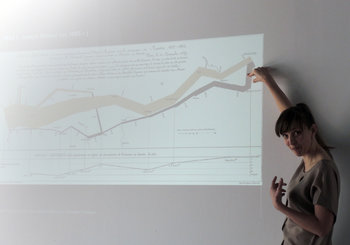
Strategy
A data driven strategy looks for hard evidence to support a strategic direction as opposed to a logical argument or intuition. For example, a telecom firm that measures its information technology spending as a percentage of revenue and finds this is higher than the competition may develop a strategy to cut IT costs. This can be compared to logic based strategies with weaker supporting data such as the argument that a firm is building important competitive advantages that will pay off in the long run.Design
Data can be used to drive any type of design including architecture, interior design, user interface design, visual design and product design. For example, a firm that buries functions that are used by less than 4% of users deep in a user interface such that they are difficult to find. This can be easily justified with data but may neglect factors such as the possibility these functions are extremely important to the 4% of people who use them and that these users may be influential in some way.Automation
Using data to automate work including decisions. For example, a banking website that automatically accepts or rejects applications for a credit card based on consumer credit data. This may have ethical and compliance implications. For example, if data suggests people in a particular zip code are a credit risk a data driven program might simply reject all applications from this area. This may not be judged as fair and reasonable by a society.Marketing
Marketing automation or decisions that are made with data. For example, automatically retargeting visitors to your website with ads or making decisions on what ad to run based on A/B testing of click through rates.Communication
The use of data to drive communication decisions. This includes marketing to customers and communications to other stakeholders such as employees, regulators, communities, investors and partners. For example, a firm that tests 3 versions of an email to employees before sending one out. This may optimize to attempt to create target perceptions in a target audience. The risk of a data driven approach is that you can come off as inauthentic.Artificial Intelligence
Artificial intelligence is a class of machines that learns and self-improves using a technique known as machine learning. In theory, all decisions made by AI are data driven. AI is garbage-in-garbage-out such that it can make poor decisions based on the training data it is feed. It can also suffer from flawed models, machine biases and its inability to produce big picture, creative or advanced abstract thinking.Performance Management
Performance management is the process of setting goals for employee performance and then measuring performance against these goals. Many organizations have adopted the stance that all goals be measurable using methodologies such as smart. Therefore, in theory, performance management is completely data driven in many organizations. This can produce negative results as employees will heavily optimize for their measured objectives at the expense of all else. If metrics are unbalanced in any way performance can be destructive but achieve a high score. In practice, most performance management is tempered with the judgement of management such that technically achieving high numbers may not excuse poor performance in unmeasured areas.Decisions
Data driven decisions are made by weighing data. This suffers from the problem that in order to make an optimal decision with data you must first select the optimal decision model. This can be shown to be a paradox whereby there is no way to guarantee you are making the optimal decision because you always have to start with an assumption such as the assertion that a decision model or algorithm is correct.Estimates
Most data that is relevant to strategy, decisions and optimization is in the future such that it must be forecast and estimated. By their nature, estimates can be inaccurate leading to poor decisions. Techniques such as reference class forecasting can be used to try to improve the quality of estimates but most forward looking values can't be predicted with certainty.Management Accounting
Management accounting is the process of measuring operational parameters, optimizing them and measuring again. For example, a firm may measure the throughput of a production line, remove a bottleneck and measure again. This has a long and established history of driving efficiency, cost reduction and quality improvement when applied to scalable operations. Firms that are overly focused on management accounting may suffer from a lack of big picture thinking such as marketing myopia whereby a firm believes that success lies in continually improving the same product.Reasoning
It is only reasonably to look for evidence to support reasoning. This doesn't mean your reasoning can't still be flawed but at least there will be hope that it is correct. For example, an individual who often feels excessively tired may begin to record their diet and activities to seek correlations. If they find that on days they eat a particular food they are more likely to feel excessively tired, it may be a reasonable theory that this food is a cause of the problem. More data can be obtained by removing the food from their diet to see what happens.Policy
The creation of rule-based policies based on data. For example, a firm that increases or decreases its capital spending based on a formula that considers factors such as economic growth projections. This is only optimal where such rules are correct and include all relevant variables. For example, there are thousands of variables that may impact investment decisions and there is no known authoritative formula for getting it right. In some cases, advocates of a data-driven approach claim that complex systems such as economies, societies and governments can be completely optimized using a rule-based approach. It is very clear from the state of social sciences and economics that no algorithms or models exist that come anywhere close to being able to deliver these claims. It is also unlikely that people would want to relinquish power to a technocratic elite who would design such rules.| Overview: Data Driven | ||
Type | ||
Definition | The process of using data to guide actions and policy. | |
Related Concepts | ||

































